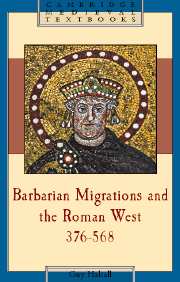Book contents
- Frontmatter
- Contents
- List of maps and figure
- Acknowledgements
- A note on spellings
- Part I Romans and barbarians in the imperial world
- 1 How the west was lost and where it got us
- 2 Defining identities
- 3 The late Roman Empire in the west
- 4 Society beyond the frontier
- 5 Romans and barbarians before 376
- Part II A world renegotiated: Western Europe, 376–550
- Part III Romans and barbarians in a post-imperial world
- Appendix: Gildas' narrative and the identity of the ‘proud tyrant’
- Bibliography
- Index
- Key to map 3 on page 75
- Cambridge Medieval Textbooks
3 - The late Roman Empire in the west
Published online by Cambridge University Press: 05 June 2012
- Frontmatter
- Contents
- List of maps and figure
- Acknowledgements
- A note on spellings
- Part I Romans and barbarians in the imperial world
- 1 How the west was lost and where it got us
- 2 Defining identities
- 3 The late Roman Empire in the west
- 4 Society beyond the frontier
- 5 Romans and barbarians before 376
- Part II A world renegotiated: Western Europe, 376–550
- Part III Romans and barbarians in a post-imperial world
- Appendix: Gildas' narrative and the identity of the ‘proud tyrant’
- Bibliography
- Index
- Key to map 3 on page 75
- Cambridge Medieval Textbooks
Summary
In 1964 A. H. M. Jones published his enormous social, economic and administrative survey, which I shall use as a paradigm of traditional ways of seeing the late Roman Empire. This is both fair, in that Jones was a very fine scholar who kept abreast of historical developments and in that his views have been enormously influential, and unfair, in that using a particular author as an example of a view of history subsequently modified – especially in a brief survey such as this – runs the risk of oversimplification and parody. Jones' book was based upon an unsurpassed knowledge of the evidence and, although now looking dated in places, especially where archaeological data (of which there was little in his day) has made a difference, for detailed depiction of the Empire's offices and institutions it is unlikely ever to be entirely replaced. And it was subtle and nuanced as only a work of nearly 1,100 pages of text and over 200 of endnotes can be. Nevertheless important features can be identified, which typify traditional thinking. Jones saw the late Roman state as authoritarian, at least in theory and often in practice. Marxist historians had deployed this idea before; Walbank, for example, saw the Empire's collapse as resulting from an oppressive bureaucracy and military, unsupportable by the period's stagnant productive forces. Theories like Walbank's profoundly influenced Jones' explanation, which also relied on the idea of a top-heavy state.
- Type
- Chapter
- Information
- Barbarian Migrations and the Roman West, 376–568 , pp. 63 - 111Publisher: Cambridge University PressPrint publication year: 2007



